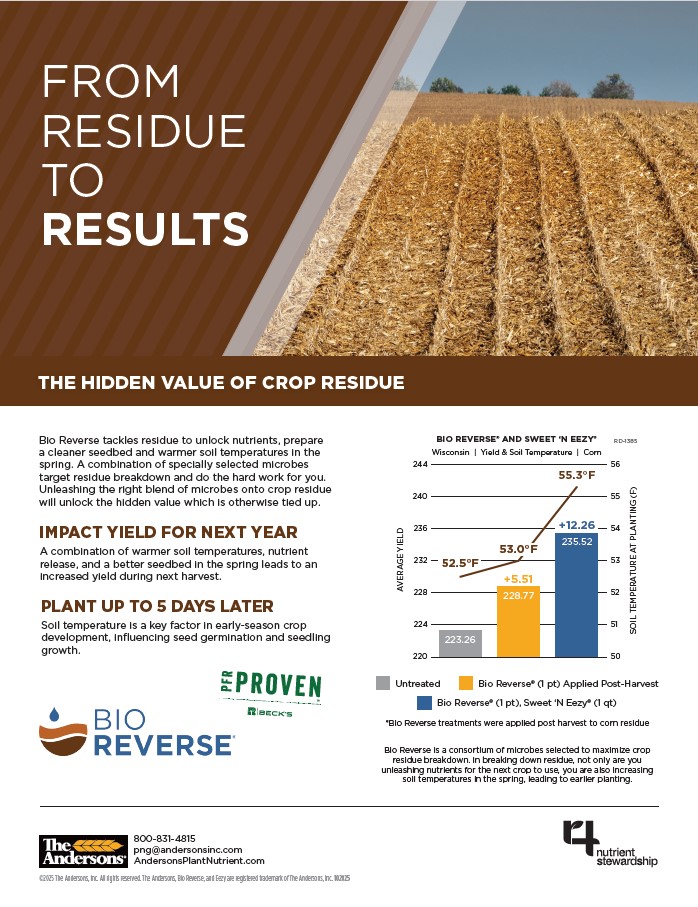Technical Bulletins
To download any of our technical bulletins, click the "Download" button below the title.
 Residue Management
Residue Management
 Hemp Fiber and Seed Production
Hemp Fiber and Seed Production
 Hemp Cannabidiol (CBD) Oil Production
Hemp Cannabidiol (CBD) Oil Production
 Organic Product Sales Sheet:
Organic Product Sales Sheet:
Nutrients for Organic Use
 Technical Bulletin 01:
Technical Bulletin 01:
Alfalfa Foliar Research in Wisconsin
 Technical Bulletin 02:
Technical Bulletin 02:
6-24-6 Outperforms Conventional Starters
 Technical Bulletin 03:
Technical Bulletin 03:
Foliar Applied Diamond 9-18-9 Increases Soybean Yields
 Technical Bulletin 04:
Technical Bulletin 04:
PureGrade® Foliar Fertilizer Boosts Crop Potential
 Technical Bulletin 05:
Technical Bulletin 05:
Low-Salt Foliar Program | Corn
 Technical Bulletin 06:
Technical Bulletin 06:
Low-Salt Foliar Application Boosts Soybean and Alfalfa Yields
 Technical Bulletin 07:
Technical Bulletin 07:
Basics of Foliar Application
 Technical Bulletin 08:
Technical Bulletin 08:
Benefits of Slow Release Nitrogen
 Technical Bulletin 09:
Technical Bulletin 09:
Calculating Salt Index
 Technical Bulletin 10:
Technical Bulletin 10:
A Review of Strip-Till and Nutrient Banding
 Technical Bulletin 11:
Technical Bulletin 11:
The Salt Index of Fertilizer is More Important Than Ever
 Technical Bulletin 12:
Technical Bulletin 12:
Orthophosphate vs. Polyphosphate
 Technical Bulletin 13:
Technical Bulletin 13:
Urea Reaction in the Soil
 Technical Bulletin 63:
Technical Bulletin 63:
Managing Fertilizer Application for Profit
 Technical Bulletin 68:
Technical Bulletin 68:
Check Planter's Liquid Starter Equipment Before Heading to the Field
 Technical Bulletin 69:
Technical Bulletin 69:
Soil Tests Offer Guidance
 Technical Bulletin 71:
Technical Bulletin 71:
First Roots Need Nutrients Fast
 Technical Bulletin 79:
Technical Bulletin 79:
Managing Risk with Split-Applications
 Technical Bulletin 80:
Technical Bulletin 80:
Increasing Irrigation Efficiency
 Technical Bulletin 82:
Technical Bulletin 82:
Tissue Test to Identify Nutrient Levels
 Technical Bulletin 83:
Technical Bulletin 83:
Avoid Issues: Understand the Differences
in Polyphosphate Fertilizer Production
Labels, Product Sheets & SDS Documents
Labels, product sheets and safety data sheets are listed with each product in our product listings.
Product Comparison Sheets
To download any of our product comparison sheets, click the "Download" button below the title.
 Boron Solutions
Boron Solutions
Download
 Slow Release Nitrogen Products
Slow Release Nitrogen Products
 Zinc Solutions
Zinc Solutions
 PureGrade: GoldStart
PureGrade: GoldStart
 PureGrade: Diamond
PureGrade: Diamond
 PureGrade: Premium
PureGrade: Premium
 Calcium Solutions for Specialty Crops
Calcium Solutions for Specialty Crops
 Zinc Solutions for Specialty Crops
Zinc Solutions for Specialty Crops
 Boron Solutions for Specialty Crops
Boron Solutions for Specialty Crops

A properly-timed nutrient management program is essential for maximizing yields at harvest. Both corn and soybeans have different nutrient needs at varying stages throughout the growing season. Understanding these critical growth stages and providing adequate nutrition to the growing crop is key to maximize crop productivity and achieve higher yields at harvest.
Click here to download The Andersons High Yield Programs for Corn and Soybeans.
Click here to download The Andersons High Yield Programs for Sugar Beets, Potatoes, and Sweet Corn.
How do I learn more?
Reach out to your Territory Manager from The Andersons.

Interested in becoming a Dealer or Distributor?

© 2020 The Andersons, Inc. All Rights Reserved.
Brochures and White Papers
To download any of our brochures, click the "Download" button below the title.
2021
Specialty Product Guide
Biological Solutions Brochure

2023 Research Trials
2022 Research Trials Brochure

2021 Research Trials Brochure
2020 Research Trials Brochure
2019 Research Trials Brochure
Resources
Below are some of the websites that we have found to be most beneficial to our customers.
Andersons Business Groups
Andersons Trade Group
Andersons Ethanol Group
Andersons Rail Group
Industry Information
4R Nutrient Stewardship
International Plant Nutrition Institute
Responsible Ag
Fluid Fertilizer Foundation
Crop Protection Chemicals
Corteva Agriscience
Bayer Crop Science
Syngenta
FMC
BASF
Seed
Asgrow and Dekalb
Pioneer
Credit and Loans
American Business Credit Farm Equipment Leasing and Loans
Farm Credit
Ag Credit
USDA Farm Loan Program
Precision Agriculture
Trimble
Ag Leader
Weather
The Weather Channel
Spraying
TeeJet
Enlist and Enlist Duo
XtendiMax
Engenia
FeXapan
EPA - Certified Pesticide Applicator Instructions
Agricultural Magazines
Progressive Farmer
Successful Farming
U.S. Farmer
No-Till Farmer
Farm Journal
Crops and Soils Magazine
Ag Web
Agricultural Universities
Michigan State University College of Agriculture and Natural Resources
Ohio State University Agronomic Crops Network
Purdue University Pest and Crop Newsletter
University of Illinois Extension
University of Nebraska - Lincoln Agricultural Research Division
Oklahoma State University Division of Agricultural Sciences and Natural Resources
University of Minnesota
Iowa State
University of Missouri
Government Agriculture Organizations
United States Department of Agriculture Farm Service Agency
United States Department of Agriculture
Natural Resources Conservation Service
National Association of State Departments of Agriculture
United Soybean Board
American Soybean Association
National Corn Growers Association
American Farm Bureau Federation
Analytical Labs
Waypoint Analytical
A&L Great Lakes
Midwest Laboratories
Ward Laboratories
Approved Tank Mix Partners
Learn more about The Andersons approved products for tank mixing with specific herbicides.
STORAGE AND CLEANING GUIDELINES FOR LOW-SALT FERTILIZER TANKS
Quality is the foundation of our products and manufacturing processes. We want to provide you with the highest-quality products to help grow your operation. To ensure the quality you expect, we focus on five key points during the manufacturing process:
- Pressing suppliers for the highest quality raw materials
- Refining manufacturing processes for maximum efficiency and environmental sustainability
- Implementing and maintaining quality management processes and systems
- Performing rigorous testing to ensure each product is manufactured to specifications
- Continuous evaluation and improvement of these processes
Quality management does not end once a product leaves our facility. Our customers play a key role in upholding quality. Once we have produced and shipped a product, it is in our dealers’ and distributors’ hands to maintain the product’s integrity until it reaches the field. To assist with this process, we have developed the following tank storage and cleaning guidelines.
We hope you find these guidelines useful. Thank you for trusting The Andersons to produce high-quality products that will help you reach your goals. Please contact us or your representative from The Andersons if you have questions or comments.
GENERAL STORAGE GUIDELINES FOR LOW-SALT FERTILIZERS
When storing low-salt fertilizers, follow these Dos and Don’ts:

CLEANING GUIDELINES
Safety Guidelines
Before starting any preparations or cleaning procedures, be sure to wear the proper personal protective equipment (PPE). Consult the product SDS for any additional PPE requirements or safety precautions. Follow these best practices:
1. Wear appropriate waterproof boots with good traction on the soles
2. Utilize safety goggles with face shield
3. Use chemical-resistant gloves
4. Wear appropriate head and body protection
Additional safety precautions:
1. Make sure the tank is free of all product up to the manway opening.
2. Be aware of the manway cover weight and use additional help when removing
bolts and the cover.
3. Isolate the tank and fill lines before opening manways. Make sure all fill valves are
closed and secured.
4. Follow the permit-required confined space entry protocol.
5. Test the air quality. Provide additional mechanical ventilation, if necessary.
6. Make sure all submersible pumps and electrical cords have an appropriate GFCI.
7. Be extra aware of heat exhaustion risk for personnel. Rotate entrants frequently.
8. Maintain control over the pressure washer trigger but do not tape or bypass the
trigger in the open position. Ensure appropriate pressure regulation.
9. Beware of carbon monoxide contamination. Make sure the pressure washer is
located outside the tank and away from the manway or ventilation intake.
Tank Cleaning Procedure
1. Remove all liquid from the tank.
2. Inspect the interior of the tank for solids. If solids are present, remove loose solids
and repurpose. You may use solids/sludge/rinsate to make suspensions or solid
fertilizers or apply to a field with a manure spreader using proper agronomic rates.
3. Before cleaning, spray the bottom to remove residue from the sump or cone. Use
of a pressure washer is recommended.
4. Starting from the top of the tank and working down, spray the roof and the inside
walls of the tank. Be cautious of trip/slip hazards caused by the hoses and slick
floor surface.
5. Once the tank has been washed from top to bottom, add enough water to avoid
starving the pump and recirculate for 10 minutes, if possible.
6. Use the system pump and drain the tank.
7. Repeat steps 2 through 6 two more times. If residue remains, use hot water and
detergent and rinse thoroughly.
8. Clean or replace screens and hoses.
9. Perform a final inspection to ensure the tank and hoses are clean and free of all
solids and liquids.
10. Allow the system to dry before filling with another product.
For questions, contact your Territory Manager from The Andersons.






















 Boron Solutions
Boron Solutions












